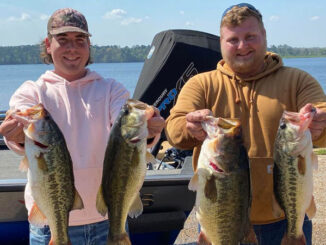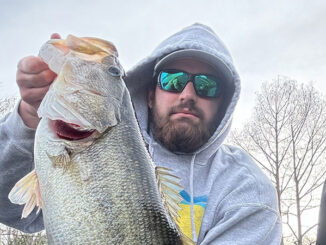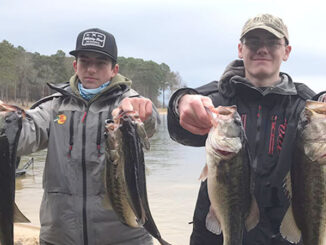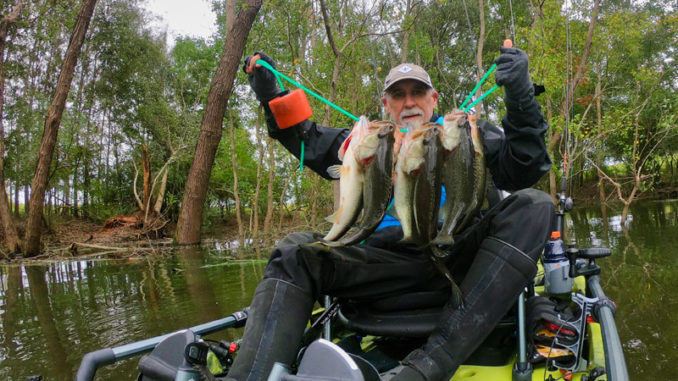
Interest in bass fishing from kayaks is exploding. Several national tournaments have organized that mimic tour-type pro bass tournaments that hop from state to state. Prizes have risen to unheard of amounts, and tournaments are even attracting professional bass tour anglers.
Kayak bass anglers from many parts of the country have shut down for the winter, but not Louisiana anglers. We have excellent year-round fishing, except for those few, extreme-winter days we may get each year with a bit of ice or even snow. All that is required to be successful catching bass from a kayak in the winter are a few extra safety precautions and a determination to change your fishing habits.
Fortunately for Louisiana anglers, bass are available throughout the state, from northern lakes to southern marshes. The only exception is the extreme coastal areas where the salinity is too high. However, even many of those areas are becoming more brackish, and saltwater anglers are more and more finding some nice fat bass to add to their coolers.
Safety
Safety is always the No. 1 precaution. Wearing a quality PFD is a must, because entering cold water greatly reduces reaction and survival time. Kayak fishing greatly exposes anglers to the elements. There is no protection from wind or rain. You are going to get somewhat wet due to the close proximity to the water, and there is always the chance of entering the water unexpectedly. Windproof and waterproof clothing is the best bet to avoid deadly hypothermia. This goes for several body layers, as well as hats, footwear and gloves. Dress for the worst-case scenario with the ability to adjust layers as conditions may change.
Although a good idea for any season, a survival kit in your kayak is essential for winter fishing, because hypothermia is the biggest danger faced when fishing in cold weather. The basics included should be a solar blanket and a fire starter (waterproof matches, butane lighter, flint/striker, etc.), which can be used to provide life-saving warmth. The kit should also include a flashlight, first-aid supplies and a marine radio. High-protein snacks such as beef jerky, trail mix or energy bars and some water should also be included. A dry bag with a towel and extra clothing is also a good idea. There is no reason to fear fishing in cold weather; just take the proper precautions and use some good, common sense.
What you need
Using a fish finder is a great aid for winter bass fishing. Both the bait and fish tend to pack tighter and hold in specific areas as the water temperatures drops. Finding them doesn’t always mean catching them, but you know where they are when they decide to eat. Slow and deliberate should be the motto. Of course, kayaks are great platforms from which to do this.
Although you do not need a yak-full of lures, you should be prepared to cover the entire water column. Frequent lure changes can be very productive in providing something just different enough to trigger a strike from lethargic bass. Don’t overlook covering the same spots using a different lure. If you’ve caught a few on a spinnerbait and the bite slows, tie on a jerkbait or lipless crankbait to change the menu. The best thing about these styles of baits is that they can be fished at varying depths and speeds, and changes in action can easily be imparted with variations of rod movements. Find what works and repeat until it doesn’t.
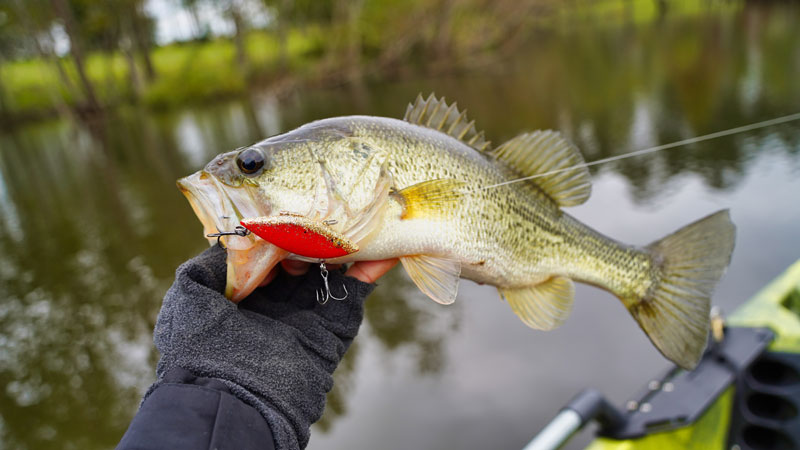
As the day wears on, slight increases in water temperatures can be the difference in a bass watching your lure swim past or inhaling it. However, cold-water bites can be slow and subtle. Try using braided line to greatly improve your chances of feeling the fish strike your bait. When in doubt, set the hook. It may be a slight change in pressure from a fish hitting the lure, or it may be a branch. There is only one way to know for sure.
Toledo Bend
Although revered for its giant bass during the spawn, Toledo Bend offers some great winter fishing. Fish the back of protected coves where bass tend to gather on warmer days. This keeps you out of the wind and cold and makes for more comfortable fishing. On colder days, use a depth finder to locate submerged grass. Smaller baits and slower presentations are often the key to catching winter bass on Toledo. These same techniques work well in similar lakes across Louisiana.
If fishing the brackish marsh in coastal areas, depth is a relative term. Five feet can be a deep spot in an area that is mainly 2 to 3 feet deep. Search out-cuts between lagoons and bays as well as the outside turns of bayous where the current cuts a deeper edge. Jerkbaits work well in these areas. They can be rigged weedless and worked extremely slowly. Line watching is a great way to detect subtle bites. Braided line floats, and if you keep a keen eye where it drops below the surface, you will see the line twitch or move slightly — set the hook.
Unlike fishing non-tidal lakes, the winter marsh is affected by cold fronts causing low water. This can be an advantage to kayak bass anglers. You will likely be able to access some areas that boat anglers cannot. Even if you don’t find fish stacked up, you can usually find one here and there as you slowly work all of the most likely areas.
Don’t put the kayak away in the winter if you like to catch bass. Make some changes to your wardrobe and pack a few safety items. Make accommodations to your techniques, and you can have some hot fishing even on cold days.
